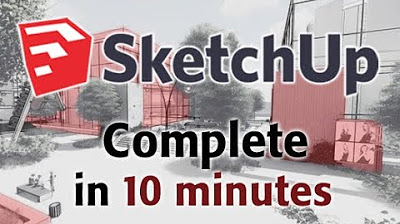Character Design Secrets Everyone Should Know
Summary
TLDRConcept artist Evgeniy Evstratiy shares tools and techniques for creating emotionally evocative designs. He discusses starting with an idea, exploring inspiration, and using methods like visual mix, reverse approach, and genre fusion. He emphasizes the importance of silhouette, proportions, and scale in character design, and how outfit and equipment can convey character identity and personality.
Takeaways
- 🎨 A good design effectively fulfills its function and solves the problem, whether set by a project team or the artist's personal goal.
- 🌟 For personal design projects, inspiration can come from other artists' work, games, movies, or creating your own unique project like 'Gold Rush'.
- 🤔 To generate ideas, explore methods like visual mix, 'what if' scenarios, reverse approach, scale experiments, influence of environment, genre fusion, and anachronisms.
- 📚 Gathering references is crucial, categorized into mood boards for inspiration, general references for starting points, and supportive references for understanding constructions or specific objects.
- 👤 The design process typically starts with silhouette, proportions, and scale, which are the first things viewers notice and interpret.
- 🧩 Silhouette is the character's contour influenced by proportions, outfit, equipment, hairstyle, and posture.
- 🔍 Proportions are the relationship of sizes and shapes of different parts of an object, and scale is the ratio of a character's size to a normal human.
- 👀 Facial features and emotions are the most direct indicators of a character's emotional state and intentions, making them top priority in character design.
- 👗 Outfit and equipment help define a character's social status, profession, hobbies, and cultural or subgroup belonging.
- 💼 Iconography in character design involves using visual symbols and stereotypes to convey character traits and roles, such as turning a simple figure into a cowboy or a pirate with a few key attributes.
- 👢 Footwear can also contribute to a character's archetype, subculture, or profession, and can affect the character's overall dynamic or heaviness.
Q & A
What is the primary role of a concept artist in the gaming industry?
-A concept artist in the gaming industry is responsible for creating visual designs that effectively evoke emotions and fulfill the project's requirements or the artist's personal goals.
How does one determine if a design is good according to the script?
-A good design is one that effectively fulfills its function and solves the problem set by the project team or the personal goal of the artist.
What can be a starting point for creating a personal design project without a predefined task?
-One can start by drawing inspiration from another artist's work, a game, or a movie, or even create their own unique project like the fictional 'Gold Rush' world.
What are some methods to generate ideas for a design?
-Some methods include visual mix, exploring unconventional scenarios by asking 'what if?', reverse approach, scale experiments, influence of environment, genre fusion, and anachronisms.
What is the significance of gathering references in the design process?
-Gathering references is crucial as it helps in understanding the theme and setting of the design, and it provides inspiration, sets a style, and aids in drawing constructions or specific objects, clothing elements, or mechanisms.
How are references categorized in the design process?
-References are categorized into mood boards for inspiration and style, general references for starting points on characters, and supportive references for understanding and drawing specific details.
What are the key elements that viewers notice and interpret first in a character design?
-The key elements that viewers notice first in a character design are the silhouette, proportions, and scale.
What is the importance of silhouette, proportions, and scale in character design?
-Silhouette, proportions, and scale are important as they form the foundation of a character's design, influencing the character's contour, general shape, and the relationship of sizes and shapes of different parts.
How can the design elements like shape language, gears, weapons, clothing, and armor contribute to a character's design?
-These design elements contribute to a character's design by adding depth and detail, enhancing the character's personality, and providing visual cues about their role or background.
What role does color, texture, and pattern play in the design process?
-Color, texture, and pattern play a significant role in the design process as they can carry emotional load, suggest psychological states, or indicate belonging to certain groups or ideologies.
How can the principles of iconography be applied in character design?
-The principles of iconography can be applied in character design by using visual stereotypes and cultural symbols to convey information about the character's identity, profession, or cultural background.
What is the difference between grounded and entertainment designs?
-Grounded designs focus on realism and practicality, often seen in the film industry, while entertainment designs, common in games, prioritize engagement and stylization, often embracing exaggeration.
Outlines

This section is available to paid users only. Please upgrade to access this part.
Upgrade NowMindmap

This section is available to paid users only. Please upgrade to access this part.
Upgrade NowKeywords

This section is available to paid users only. Please upgrade to access this part.
Upgrade NowHighlights

This section is available to paid users only. Please upgrade to access this part.
Upgrade NowTranscripts

This section is available to paid users only. Please upgrade to access this part.
Upgrade NowBrowse More Related Video

How To Shade and Render The Body - How To Draw

6 Steps to Draw Anything

Canva से Thumbnail बना कर Daily 500₹ Earn करे | How To Earn Money With Canva |Canva Tutorial In 2024

SketchUp - Tutorial for Beginners in 10 MINUTES! [ COMPLETE ]

What Makes a Great Concept Artist - Finnian Macmanus

How to grow on social media as an artist
5.0 / 5 (0 votes)